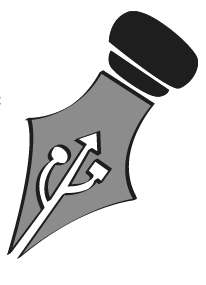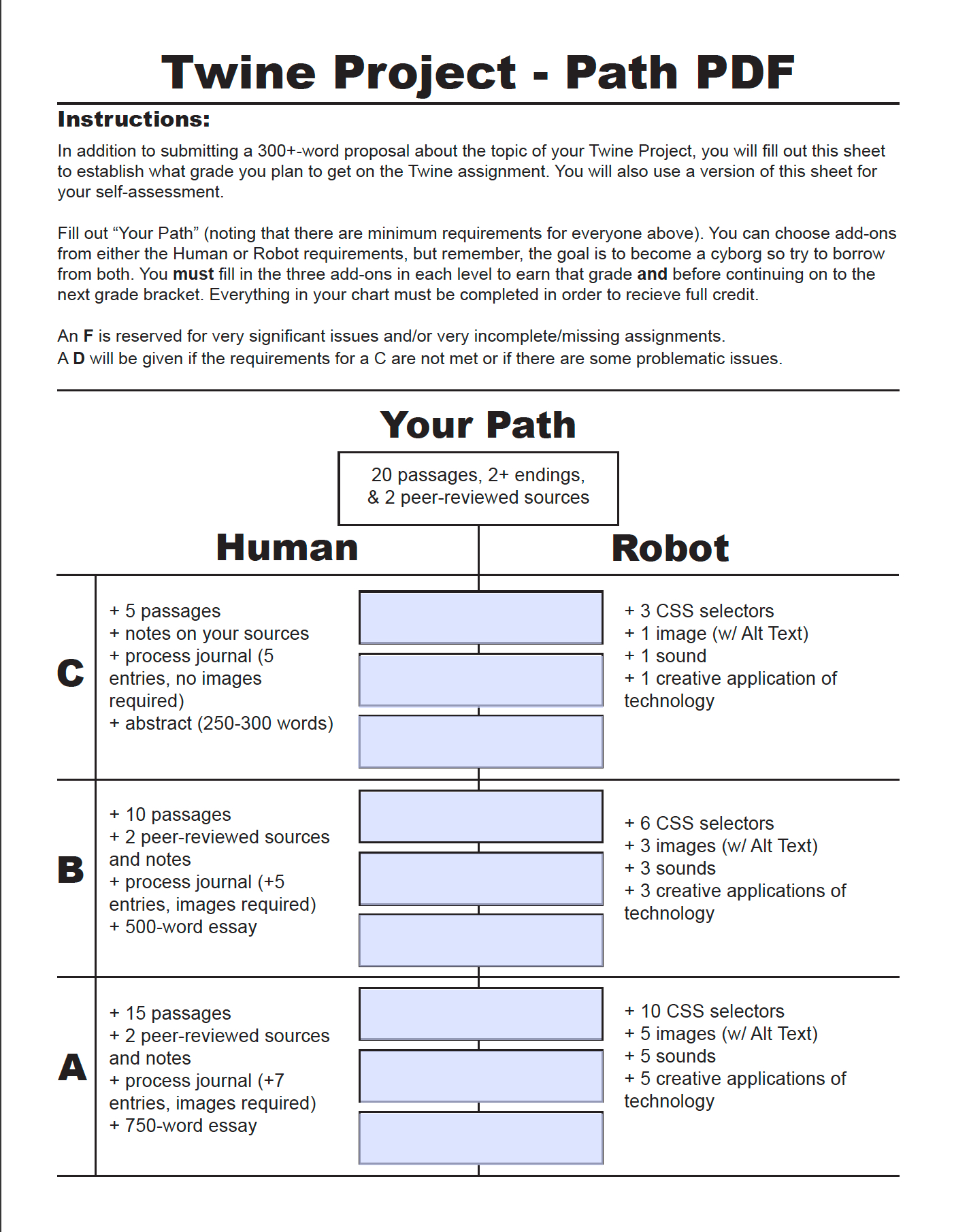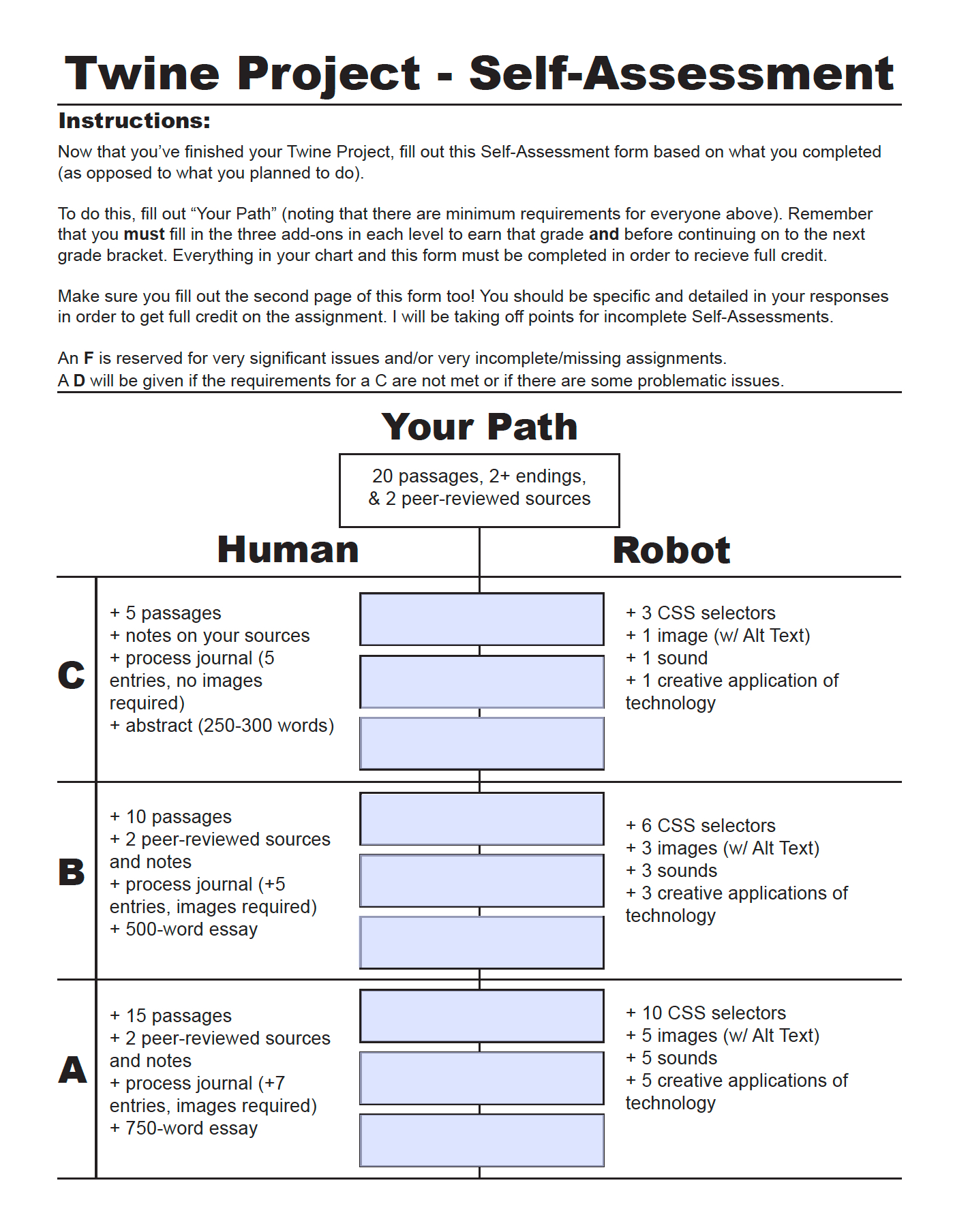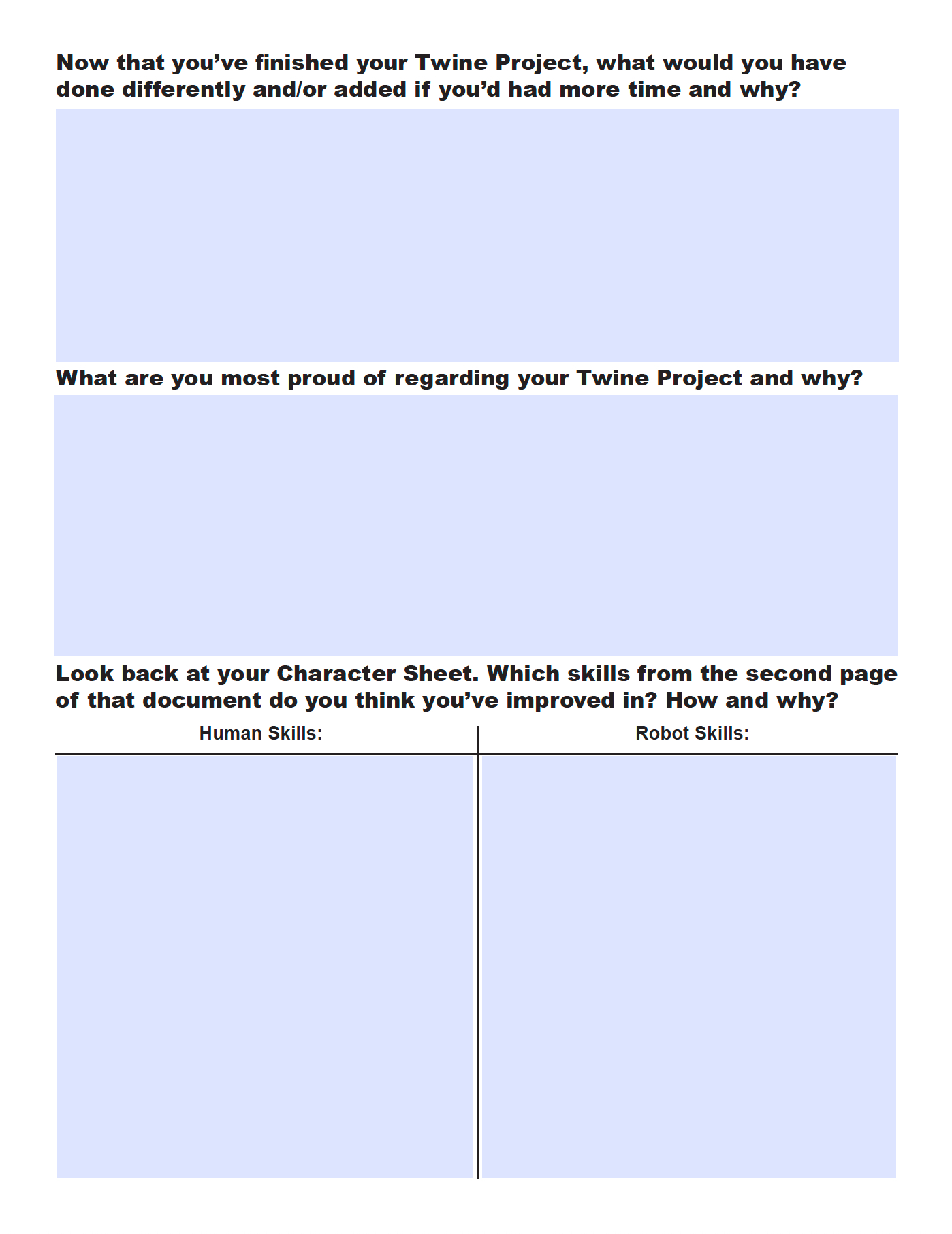Deanna Stover's Courses

Deanna Stover is an Assistant Professor at Christopher Newport University. This website is a compilation of her syllabi since starting at CNU in Fall 2020.
Twine Project
Proposal/Path Deadline: Sunday, September 18th by 11:59 pm
Percentage: 5% (required)
Meetings with Me: Week 5
Sharing Days: Friday, September 30th; Friday, October 7th; Wednesday, October 12th
Final Twine Game and Self-Assessment Deadline: Monday, October 17th by 11:59 pm
Percentage: 20%
General Overview
First of all, Twine is kind of like a Choose Your Own Adventure story. It’s an interactive, non-linear hypertext storytelling medium. We’ll be learning how to use Twine and how to customize it using some basic coding.
For this assignment, you’ll create a Twine game about a social issue (current or historical–after all, history informs the present) related to college students, but you can be creative about how you tell the story.
You’ll write a project proposal before you get too deep into the Twine game so I can make sure you’re headed in the right direction.
Some topic ideas (but this list certainly isn’t exhaustive!):
- first-generation college students
- minority students at a primarily white institution (PWI)
- disability and education
- mental health and college
- “self care” and college
- COVID-19 and the “college experience”
- college in the age of “fake news”
- a day in the life of a CNU student
- working a job (or more than one!) while being in college
- community engagement and service during college
- student athletes
- social activities in college (clubs, for instance)
I should note that sometimes it’s easiest to work with a topic that you have personal experience with. That said, I do expect you to do academic research that backs up the choices your player is given in the game itself, so please don’t choose a topic if you are unwilling to have your beliefs questioned. I also want everyone to be respectful and kind to their classmates, so be aware of the language and framing you use when addressing controversial topics.
Assignment Breakdown
Proposal/Path - Sunday, September 18th by 11:59 pm
Your proposal should be 300+ words and explain both your topic and its social relevance to either the CNU community or college students more broadly. You must also fill out and submit the Path PDF. More information on this is below.
I will not accept the other portions of this assignment until your proposal/path has been approved.

Meetings with Me - Week 5
For your meetings with me, you should prepare by finding at least 2 peer-reviewed sources about your topic and bringing them to the meeting.
Sharing Days
You can sign up for a Sharing Day to earn 5 extra points on the assignment. No one is required to present during a Sharing Day, but this will boost a C grade to an 80, a B grade to a 90, and an A grade to a 100. (The five points will still apply even if you don’t quite reach the minimum requirements for a C, meaning if you get a D grade on the assignment but participate in the Sharing Day, you can get up to 70%).
In order to get the full five points, you must give a 3-5 minute presentation about your progress on the Twine assignment. For this presentation, you must include a slide show with images or give a tour of your Twine project-in-progress. There can only be up to 7 presenters on a single Sharing Day, so do sign up early (through the Shared Google Drive) if you are interested and make sure you are prepared to present your works-in-progress on that day. You should also practice your presentation in order to stay under five minutes.
Any slide shows or Twine projects you plan to tour should be sent to me by 11:59 pm the day before you present.
Sharing Day #1: For Sharing Day #1, you should have started working in Twine, but your project by no means needs to be complete. These presentations may focus more on the research you’ve done, the other resources you’ve gathered (such as images and sounds), or any planning documents in addition to showing your current progress in Twine.
Sharing Day #2: Projects shared during the second sharing day should show a substantial amount of progress on the assignment. While you can certainly discuss the research you’ve done and the resources you’ve gathered as well as any planning documents, you should also provide a glimpse at a substantial portion of your project in Twine itself.
Sharing Day #3: Projects at this stage should be mostly complete with very little editing left to be done. So, while you can talk about your research and other resources, you should be primarily focusing on what you’ve built in Twine.
Final Twine Project/Self-Assessment - Friday, October 14th 11:59 pm
In addition to submitting your final Twine project, you will complete a self-assessment using a form that’s similar to the initial Path PDF, but this version will reflect what you actually did, as opposed to what you planned to do, while also asking some questions about the final product. After all, the point of the Twine project is to be both “creative and reflective” (a key component to DH and Interactive Fiction as Anastasia Salter argues in “Why Twining?”), so this Self-Assessment is crucial to your success on the project. I will not accept Twine projects without a completed Self-Assessment form.


What do all the parts of the Path PDF/Self-Assessment Form mean?
Path PDF
Human Options
Passages
Everyone starts out with at least 20 required passages, but you can also add on passages as part of Your Path. You can stack these, meaning you could potentially end up with a game that is 50 passages long. Each passage refers to each of the sticky-note looking parts of Twine–but all passages need to connect to at least one other passage to count (or they won’t show up!).
You may want to create a “passage” with just code that affects the entire game–that passage does not count towards your passage total, but would count towards your Robot path under “Crative Applications of Technology.”
Notes on Sources
Everyone must use at least two peer-reviewed sources, but as part of the first bracket (the “C” bracket) you can choose to take notes on these sources. If you choose to add sources as part of the other brackets (“B” and “A”), you must take notes on these sources as well.
For the notes, you need to write a 100+ word description of each source including it’s main argument and how it helped with your project.
Adding Sources
You can also choose to add peer-reviewed sources as part of both the “B” and “A” brackets. You must take notes on any sources you add in these brackets.
Sources can stack, so you can have as few as two sources and as many as 6.
Process Journal
The Process Journal option is available in all three grade brackets and can stack, so you can do as little as 5 entries with no images to as many as 17 entries with images.
Each entry of the Process Journal should reflect on your experience as you make the project. So, this requires some forethought on your part.
Essentially, you’ll want to write at least 75 words per entry that explains what you’ve been working on and how the project is going (including your struggles and successes) throughout the creation process. Any images should show your progress (you might, for instance, take a screenshot of Twine as you progress, starting with just a few passages, and illustrating how it grew as you developed the project or you might take screenshots of the CSS and how it developed as you worked on the project or a combination of things).
Abstract
As part of the first bracket, you can choose to write an abstract about your game. This 250-300 word abstract should describe your game and its significance/purpose. Think critically about what your game is doing and who it is for!
Essay
You can choose to write an essay as part of the upper two brackets. These can stack, so you can write a 500-word essay, and 750-word essay, or a 1,250-word essay. This essay should be written once your game is (mostly) finished (as opposed to the Process Journal that discusses the game as you create it).
Your essay should tie your research back to the choices you made in creating your Twine game.
Robot Options
CSS Selectors
CSS (or Cascading Style Sheet) is how you make your game look a certain way. For example, in Depression Quest, Zoe Quinn used CSS to make some choices crossed out and red. CSS is also how you change the background color, text size, etc.
A CSS selector encompasses all changes you make to a single category. So, if you change the background color, text color, and the font-size of the body, this would count as one selector, not three. Here’s an example of a single selector:
body {
background-color: white;
color: purple;
font-size: 150%;
}
The CSS Selectors categories can stack, so you can have as few as 3 CSS selectors and as many as 20 (or more–they just won’t give you extra points).
Images (with Alt Text!)
You can add images at any part of the bracket and these can stack, meaning you can have as little as one image and as many as 9 images (or more–they just won’t give you extra points).
All images should include Alt Text because this is the best practice for accessibility. Alt Text means that you briefly describe the image in words and, while this won’t show up when you’re playing the game (unless the image is broken), screen readers will be able to pick up the Alt Text.
Sound
You can add sound at any part in the bracket and these can stack, meaning you can have as little as one sound and as many as 9 sounds (or more–they just won’t give you extra points).
Creative Applications of Technology
This part of the bracket refers to any additional extended use of technology that doesn’t fit into the CSS, Images, or Sound categories. So, for example, you might use variables, one example being having players enter their own name at the beginning of the game and then using it to refer to the player throughout. Another example might be having some sort of status meter that tracks a users progress throughout the game. The opportunities are practically endless, so I don’t want to be prescriptive, but we can certainly talk about ideas in Office Hours or during class!
These can stack, so you can have as little ast one creative application of technology and as many as 9 (or more–they just won’t give you extra points).
Self-Assessement Form
The first page of the self-assessment form is the same as the Path PDF (except fot the instructions). Fill this portion of the form out based on what you actually did rather than what you planned to do.
The second page asks you to be reflective and think about the final Twine piece you created, particularly in terms of what you would have done differently or expanded on with more time, and what you’re most proud of.
Evaluation
You will receive the grade you choose if you have completed the appropriate brackets successfully, meaning that you have followed the directions for each section. So, images must work (and have Alt Text) to get credit for them, the abstract must be between 250-300 words and discuss both the game and its significance/purpose to be included, etc. So, essentially, you are being graded based on completion, but each of these components must be complete and working to count towards Your Path.
Late Work
I will be subtracting 5 points for every day your assignment is late unless you’ve been been given an extension.
I owe credit to S. Einstein and M. Vetter for their Twine Assignment.